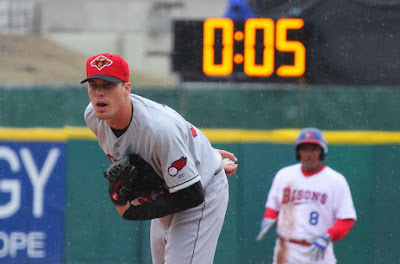*Photo from the Boston Globe*
Get ready baseball fans, some big changes are coming. MLB announced that it's competition committee has voted to approve the implementation of 3 major rule changes to the game on Friday morning.
The rules being implemented are ones that have been hot topics for a few years now. A pitch clock will be added to the major leagues, defensive shifts will be banned, and bases will become larger. The vote to expand base sizes was unanimous, while pitch clock addition and shift bans were not unanimous votes, according to Jeff Passan of ESPN.
What is considered to be the most noteworthy change is the pitch clock. Tested in the minor leagues for years, it has had a drastic effect on game times when strictly enforced, cutting the average game time to two hours and 30 minutes. How it works is the catcher must be squatted down and in position to receive the pitch with 10 seconds left on the clock. The batter must have both feet inside the batters box and be ready to swing with 8 seconds to go. The pitcher must begin the throwing motion before the clock hits 0. Any violation by the pitcher gives an automatic ball to the batter, and any violation by the batter gives an automatic strike to the pitcher.
When it gets implemented, the pitch clock will be set for 15 seconds with the bases empty, and 20 seconds with at least one runner on base. Pickoffs and pitchers stepping off the mound resets the pitch clock, but there is a limit of two per at bat, with the number reset to two if a runner advances. A pitcher is allowed a third pickoff attempt, but if the runner is safe, it will be called a balk and all runners will advance one base.
Shifts came into the game as a strategy to stop hitters from getting on base by playing more fielders where a hitter hits the ball more frequently. It started out as a valuable tool for managers, but it has since become heavily used as analytics become more prevalent in the current era of baseball. More often than not, you'll see a team infield shifted, and MLB has now implemented a ban to the shift.
Now, all 4 infielders will need to have both feet on the dirt when the pitch is thrown. Two infielders will need to be on both sides of second base at all times, so you won't see 3 infielders playing on one side of the diamond. Teams have to designate which infielders will be playing on the left side, and which will be on the right prior to first pitch. Those infielders cannot switch sides of the infield unless a defensive substitution is made.
The alignment of a team's infield defense is now reviewable as well. If a team's defensive format is deemed illegal after review, the hitting team can choose to accept the outcome of the play, or can choose to have an automatic ball awarded to the hitter.
Now, let's get to the larger bases. The bases will expand from 15 square inches to 18 beginning next season. The belief is that the bigger area of the base will help to cut down on collisions at the base, and it shortens the distance between bases, which would make it easier for runners to steal bases. Stolen base rates have increased in the minor league levels that have larger bases, so it could happen in the majors as well.
To recap it all, these rule changes are significant and will have a noteworthy impact on in game play. Stolen base rates are likely to rise, average game time is expected to drop with the pitch clock, and with the shift effectively outlawed, career pull hitters will likely see an uptick in their stats. It will be interesting to watch it all play out.

Comments
Post a Comment